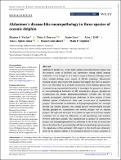Files in this item
Alzheimer’s disease-like neuropathology in three species of oceanic dolphin
Item metadata
| dc.contributor.author | Vacher, Marissa C. | |
| dc.contributor.author | Durrant, Claire S. | |
| dc.contributor.author | Rose, Jamie | |
| dc.contributor.author | Hall, Ailsa J. | |
| dc.contributor.author | Spires-Jones, Tara L. | |
| dc.contributor.author | Gunn-Moore, Frank | |
| dc.contributor.author | Dagleish, Mark P. | |
| dc.date.accessioned | 2023-01-06T12:30:05Z | |
| dc.date.available | 2023-01-06T12:30:05Z | |
| dc.date.issued | 2023-04-01 | |
| dc.identifier | 282566255 | |
| dc.identifier | 44fe2dc2-217f-45ab-8d85-f82cdc093820 | |
| dc.identifier | 85145330760 | |
| dc.identifier | 000906026200001 | |
| dc.identifier.citation | Vacher , M C , Durrant , C S , Rose , J , Hall , A J , Spires-Jones , T L , Gunn-Moore , F & Dagleish , M P 2023 , ' Alzheimer’s disease-like neuropathology in three species of oceanic dolphin ' , European Journal of Neuroscience , vol. 57 , no. 7 , pp. 1161-1179 . https://doi.org/10.1111/ejn.15900 | en |
| dc.identifier.issn | 0953-816X | |
| dc.identifier.other | RIS: urn:4698B2B22C6E0BB094A318AE8351997A | |
| dc.identifier.other | ORCID: /0000-0002-7562-1771/work/126031277 | |
| dc.identifier.other | ORCID: /0000-0003-3422-3387/work/126031424 | |
| dc.identifier.uri | https://hdl.handle.net/10023/26699 | |
| dc.description | Funding: This research did not receive any specific grant from funding agencies in the public, commercial or not-for-profit sectors. MCV was supported, in part, by the Erasmus+ mobility program. CD is a Race Against Dementia Dyson Fellow and Emerging Leader at the UK Dementia Research Institute. JR is supported by the UK Dementia Research Institute. AJH was funded by the Natural Environment Research Council (Grant No. NE/R015007/1). TS-J is supported by the European Research Council (ERC) under the European Union’s Horizon 2020 research and innovation programme (Grant agreement No. 681181) and the UK Dementia Research Institute, which receives its funding from DRI Ltd, funded by the UK Medical Research Council, Alzheimer’s Society, and Alzheimer’s Research UK. FG-M is supported by the RSMacDonald Charitable Trust, Rosetrees Trust and the EPSRC programme grant EP/P030017/1. MPD was funded by the Scottish Government and undertakes the detailed histological examination of cetacean tissues for SMASS which is supported by Marine Scotland, a division of the Scottish Government, and the Department for Environment, Food and Rural Affairs (defra), a department of the United Kingdom Government. | en |
| dc.description.abstract | Alzheimer's disease (AD) is the most common neurodegenerative disease and the primary cause of disability and dependency among elderly humans worldwide. AD is thought to be a disease unique to humans although several other animals develop some aspects of AD-like pathology. Odontocetes (toothed whales) share traits with humans that suggest they may be susceptible to AD. The brains of 22 stranded odontocetes of five different species were examined using immunohistochemistry to investigate the presence or absence of neuropathological hallmarks of AD: amyloid-beta plaques, phospho-tau accumulation and gliosis. Immunohistochemistry revealed that all aged animals accumulated amyloid plaque pathology. In three animals of three different species of odontocete, there was co-occurrence of amyloid-beta plaques, intraneuronal accumulation of hyperphosphorylated tau, neuropil threads and neuritic plaques. One animal showed well-developed neuropil threads, phospho-tau accumulation and neuritic plaques, but no amyloid plaques. Microglia and astrocytes were present as expected in all brain samples examined, but we observed differences in cell morphology and numbers between individual animals. The simultaneous occurrence of amyloid-beta plaques and hyperphosphorylated tau pathology in the brains of odontocetes shows that these three species develop AD-like neuropathology spontaneously. The significance of this pathology with respect to the health and, ultimately, death of the animals remains to be determined. However, it may contribute to the cause(s) of unexplained live-stranding in some odontocete species and supports the 'sick-leader' theory whereby healthy conspecifics in a pod mass strand due to high social cohesion. | |
| dc.format.extent | 19 | |
| dc.format.extent | 5231532 | |
| dc.language.iso | eng | |
| dc.relation.ispartof | European Journal of Neuroscience | en |
| dc.subject | Tau | en |
| dc.subject | Neurofibrillary tangles | en |
| dc.subject | Amyloid plaques | en |
| dc.subject | Beta amyloid | en |
| dc.subject | Immunohistochemistry | en |
| dc.subject | Cetacean | en |
| dc.subject | Odontocetes | en |
| dc.subject | QH301 Biology | en |
| dc.subject | RC0321 Neuroscience. Biological psychiatry. Neuropsychiatry | en |
| dc.subject | 3rd-DAS | en |
| dc.subject | MCC | en |
| dc.subject.lcc | QH301 | en |
| dc.subject.lcc | RC0321 | en |
| dc.title | Alzheimer’s disease-like neuropathology in three species of oceanic dolphin | en |
| dc.type | Journal article | en |
| dc.contributor.sponsor | NERC | en |
| dc.contributor.sponsor | EPSRC | en |
| dc.contributor.sponsor | Rosetrees Trust | en |
| dc.contributor.institution | University of St Andrews. School of Biology | en |
| dc.contributor.institution | University of St Andrews. Sea Mammal Research Unit | en |
| dc.contributor.institution | University of St Andrews. Scottish Oceans Institute | en |
| dc.contributor.institution | University of St Andrews. Marine Alliance for Science & Technology Scotland | en |
| dc.contributor.institution | University of St Andrews. Sir James Mackenzie Institute for Early Diagnosis | en |
| dc.contributor.institution | University of St Andrews. Centre for Biophotonics | en |
| dc.contributor.institution | University of St Andrews. Institute of Behavioural and Neural Sciences | en |
| dc.contributor.institution | University of St Andrews. Biomedical Sciences Research Complex | en |
| dc.identifier.doi | https://doi.org/10.1111/ejn.15900 | |
| dc.description.status | Peer reviewed | en |
| dc.identifier.grantnumber | NE/R015007/1 | en |
| dc.identifier.grantnumber | EP/P030017/1 | en |
| dc.identifier.grantnumber | A1163 | en |
This item appears in the following Collection(s)
Items in the St Andrews Research Repository are protected by copyright, with all rights reserved, unless otherwise indicated.

